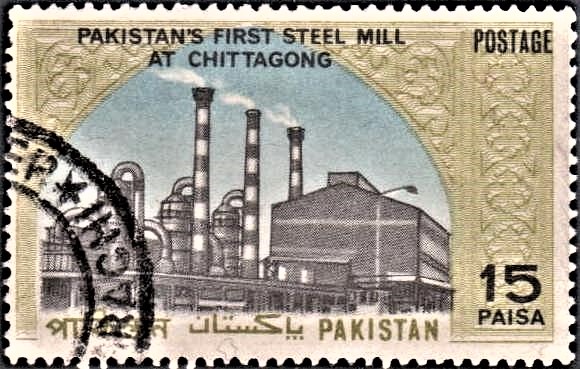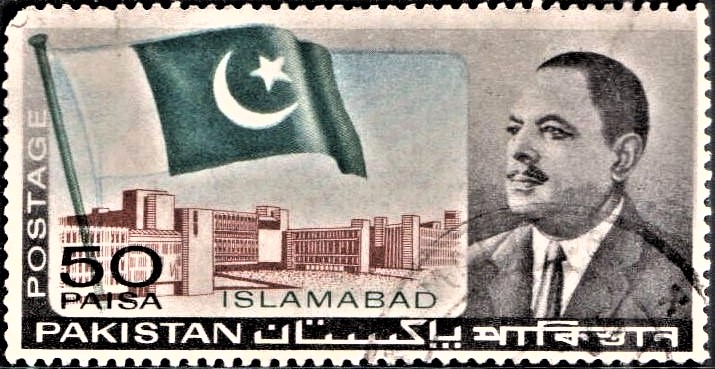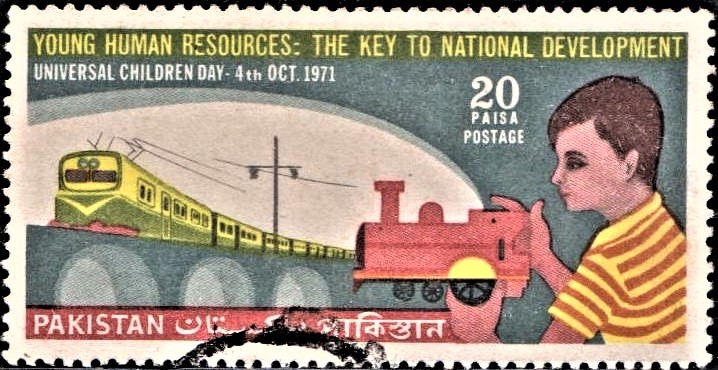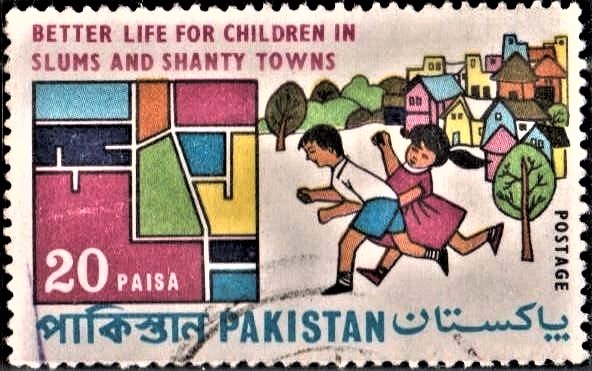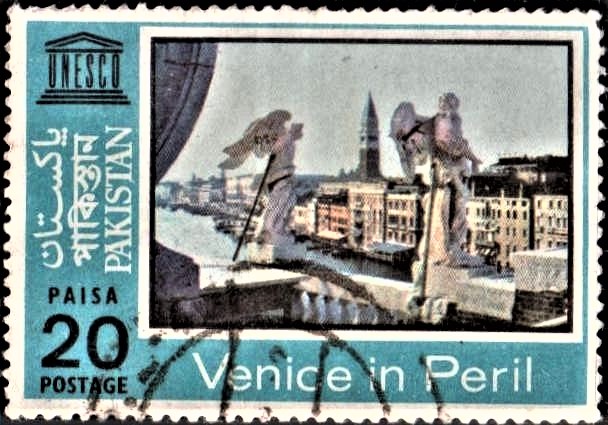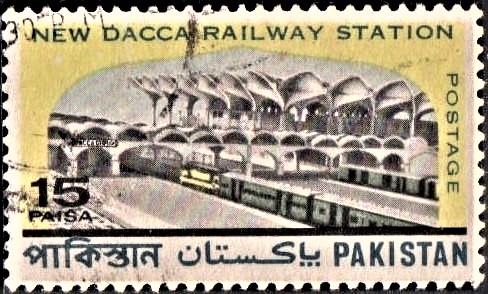
New Dacca Railway Station
A commemorative postage stamp on the Opening of the New Railroad Station at Kamalapur :
 Issued by Pakistan
Issued by Pakistan
Issued on Apr 27, 1969
Design : A panoramic view of the New Dacca Railway Station is shown through a wide arch similar to the arches of the platforms. The arch, which is yellow in colour is rested on a thick black horizontal line under which ‘Pakistan’ in Bengali, Urdu and English appears in blue colour. The station appears in tones of grey and black, with two trains standing. One train is in the foreground almost in the centre with its engine and two bogies visible. The other train appears in the background with its last bogie visible. The bogies are in green colour and the engine is in black with yellow strips. The denomination figure ‘15’ with ‘Paisa’ underneath appears at the left end of the horizontal line. The caption ‘New Dacca Railway Station’ appears in green at the top on the arch. The word ‘Postage’ in green colour appears at the right hand side of the stamp.
Type : Stamp, Postal Used
Denomination : 15 Paisa
Colour : Yellow, Blue, Green and Grey
Size of Stamp : 24 x 40.67 mm.
Size of Print : 21 x 37.67 mm.
Perforation Gauge : 13½ x 13 (c)
Quantity Printed : 15,00,000
Number of Stamps in each sheet : 50
Process of printing : Litho Offset
Printers : The Pakistan Security Printing Corporation Ltd., Karachi
About :
- The opening of the New Dacca Railway Station at Kamalapur on April 27, 1968 heralded a new era in the history of the Pakistan Eastern Railway. This station was constructed to meet the long-felt need of the growing provincial capital.
- In 1885 Dacca was only a small district town when it was linked by rail-road with the rest of the province. The Railway Station constructed at Phulbaria, a place then on the outskirts of the town, served with ease the people living in and around the urban area. It had only one platform, a small yard and a loco shed. The railroad semi-circled the town, without causing much hindrance to the people and vehicular traffic to and from the area, as the approaches to it were seldom busy and the trains running on the railroad were few. But, as time passed, volume of traffic increased, leading to increase in the number of trains, and, to complicate the situation, the city roads also became busier along with this.
- With the creation of Pakistan in 1947, Dacca became the capital of East Pakistan. Soon the city turned into a vast urban area divided by old and new zones. The roads serving these zones crossed the railway lines at many points. Trains coming to and departing from Phulbaria station and the engines shunting wagons at the yard now kept the gates at the crossings closed so frequently that the flow of vehicular traffic on the roads was seriously interrupted. This situation could not be allowed to continue for long in a busy provincial metropolis. The only remedy was shifting the Phulbaria station and diverting the railway lines to an area which was sparsely populated and less busy.
- Accordingly it was suggested in 1948 to shift the station to its present site at Kamalapur. The implementation of the suggestion was, however, kept in abeyance for about a decade. In 1958, the suggestion was finally accepted and eventually the financial responsibilities were shifted to the Provincial Government when the railways became a provincial subject. Since then the work on the shifting of the station, diversion of the railway lines from Tejgaon to Gandaria via Kamalapur and construction of office and residential buildings continued vigorously.
- The first phase of the station was completed in 1968 at a cost of Rs. 53 million. It is now the biggest railway station of the country and will become one of the largest modern stations of Asia when its second phase is completed in 1970, bringing the total sanctioned cost of the project to Rs. 131.3 million. The main buildings of the station and the yard occupy about 156 acres of land and the complex includes new railway lines, roads, staff quarters, a Rest House, a R.M.S. Building, a park, a hospital and various other amenities for passengers.
- The new station is divided into two sections, one meant for local trains and the other for trains coming from distant corners of the province. The construction of the first section involved a cost of Rs. 3.1 million while the second section was constructed at a cost of Rs. 4.8 million.
- There are 10 platforms, eleven booking counters and four double-bedded and twelve single-bed retiring rooms for passengers. The 59 feet high roof with multiple domes provides a happy blending between the modern and traditional architectural trends.
- Issued by the Director-General, Pakistan Post Office, Karachi.


